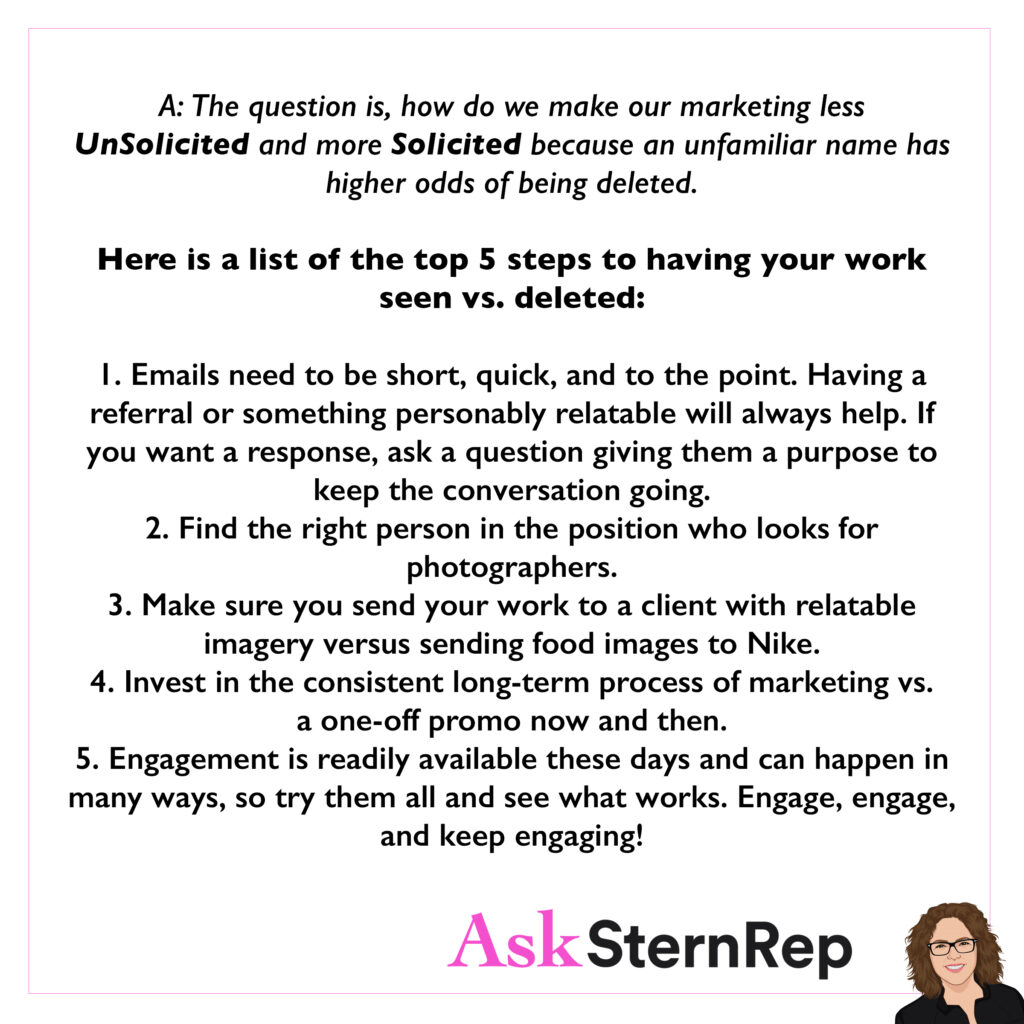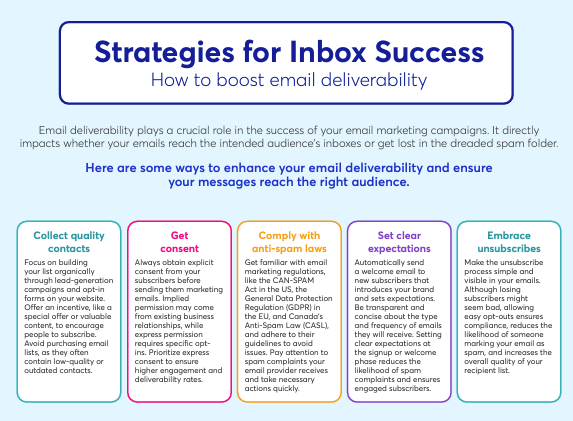No, you cannot send unsolicited marketing emails legally in many countries. Laws like the CAN-SPAM Act in the U.S. And GDPR in Europe strictly regulate this practice.
Unsolicited marketing emails, often called spam, can harm your business reputation and lead to legal issues. Sending emails without permission annoys people and can result in your emails being flagged as spam. This can lower your email deliverability rates. Understanding the legal landscape and best practices for email marketing is crucial.
You need to know how to build an email list correctly and respect your audience’s privacy. This blog post will guide you through the dos and don’ts of marketing emails, helping you stay compliant and keep your customers happy.

Credit: asksternrep.com
Introduction To Unsolicited Marketing Emails
Unsolicited marketing emails are a common practice in digital marketing. These emails are sent to potential customers without their prior consent. Though often controversial, they are a tool many businesses use to reach new audiences. Understanding the dynamics of unsolicited emails can help you make informed decisions.
What Are Unsolicited Emails?
Unsolicited emails are messages sent to individuals who have not requested them. They are also known as spam or junk mail. Businesses send these emails to promote products or services. Often, they target a large number of recipients.
These emails can be both beneficial and annoying. They can inform recipients about new offers and promotions. But they can also flood inboxes and become a nuisance. The key is to use them wisely and ethically.
Common Examples
There are several common examples of unsolicited marketing emails. Here are a few:
- Promotional Emails: These emails advertise a product or service. They often include special offers or discounts.
- Newsletters: These are regular updates sent to a broad audience. They often contain useful information mixed with promotions.
- Event Invitations: Businesses send these to promote upcoming events. This can include webinars, workshops, or sales events.
- Survey Requests: Companies use these to gather customer feedback. They might offer an incentive for completing the survey.
Understanding these examples can help you recognize unsolicited emails. It can also help you decide how to handle them effectively.
Legal Frameworks
Sending unsolicited marketing emails can be a tricky business. Legal frameworks exist to protect consumers from spam and ensure fair practices. Understanding these laws is crucial for any business engaged in email marketing.
Can-spam Act
The CAN-SPAM Act applies to all commercial emails sent in the U.S. It requires transparency in email marketing. Every email must include a clear way to opt-out. Misleading headers or deceptive subject lines are prohibited. Businesses must honor opt-out requests promptly.
Gdpr Regulations
The GDPR applies to emails sent within the European Union. Consent is key under GDPR. You must have explicit permission to send marketing emails. This means users must opt-in before receiving emails. GDPR also mandates data protection and privacy measures.
Casl Guidelines
CASL governs email marketing in Canada. Consent is vital under CASL too. There are two types: express and implied. Express consent is given directly. Implied consent is based on existing relationships. All emails must include the sender’s contact information. There must also be a clear way to unsubscribe.
Consent And Permission
Sending unsolicited marketing emails can be tricky. Consent and permission are crucial. Many countries have laws that protect users from unwanted emails. Understanding these rules can help you avoid legal issues. This section will discuss explicit vs. implicit consent and opt-in and opt-out mechanisms. Let’s dive in.
Explicit Vs. Implicit Consent
There are two types of consent: explicit and implicit. Both play a key role in email marketing.
- Explicit Consent: This is clear and direct. A person signs up for your newsletter. They know they will get emails from you. This type of consent is the best. It is clear and leaves no room for misunderstanding.
- Implicit Consent: This is not as clear. A person buys a product from your website. They might get marketing emails later. They did not sign up for this. Implicit consent can be risky. Always aim for explicit consent.
Opt-in And Opt-out Mechanisms
Opt-in and opt-out mechanisms help manage consent. They let users control the emails they get.
| Mechanism | Description |
|---|---|
| Opt-In | Users actively agree to receive emails. They check a box or enter an email. This is the best practice for gaining consent. It shows clear interest from the user. |
| Opt-Out | Users are added to a list but can choose to leave. They click an “unsubscribe” link in the email. This method is less ideal. It can lead to unhappy users and spam complaints. |
Both mechanisms have their place. Opt-in is more user-friendly and builds trust. Opt-out can be useful but should be used carefully. Always provide easy ways for users to manage their email preferences. This respect builds trust and keeps your audience happy.

Credit: www.constantcontact.com
Penalties And Consequences
Sending unsolicited marketing emails can lead to serious penalties. These can affect your business financially and damage your reputation. Understanding these risks is crucial for any marketer.
Fines And Legal Actions
Many countries have strict laws against unsolicited emails. Violating these laws can result in hefty fines. For example, the CAN-SPAM Act in the United States imposes penalties up to $43,792 per email. The General Data Protection Regulation (GDPR) in Europe can levy fines up to €20 million or 4% of annual global turnover, whichever is higher.
Here’s a quick look at potential fines:
| Law | Region | Maximum Fine |
|---|---|---|
| CAN-SPAM Act | United States | $43,792 per email |
| GDPR | Europe | €20 million or 4% of annual revenue |
Legal actions can also include lawsuits and injunctions. These can be time-consuming and costly. Businesses can face court orders to stop sending emails immediately.
Reputation Damage
Sending unsolicited emails can damage your brand’s reputation. Customers may view your brand as untrustworthy. This can lead to a loss of customer loyalty.
Here are some potential consequences:
- Increased customer complaints
- Higher unsubscribe rates
- Negative reviews and social media backlash
A damaged reputation can affect your email deliverability. Internet Service Providers (ISPs) may mark your emails as spam. This reduces the chances of your emails reaching your audience.
Maintaining a positive reputation is crucial. Respecting email marketing laws helps build trust with your customers.
Best Practices For Compliance
Sending unsolicited marketing emails can be tricky. To avoid legal issues, follow best practices for compliance. This ensures your emails are well-received and keeps you out of trouble.
Clear Subject Lines
Your subject line should clearly state the email’s purpose. Be honest and direct. Avoid misleading phrases or clickbait tactics. For example, use “Special Offer Just for You” instead of “You Won’t Believe This Deal!”. This builds trust and improves open rates.
Accurate Sender Information
Always use accurate sender information. This includes your name, business name, and contact details. Recipients should know who the email is from at a glance. For example, use “John from ABC Marketing” instead of just “ABC Marketing”. Clear identification helps build credibility.
Easy Unsubscribe Options
Every email must offer an easy way to unsubscribe. Place the unsubscribe link at the bottom of the email. Make it visible and straightforward. For example, use “Click here to unsubscribe” instead of hiding the link in fine print. This respects the recipient’s choice and maintains your reputation.
| Best Practice | Example |
|---|---|
| Clear Subject Lines | “Special Offer Just for You” |
| Accurate Sender Information | “John from ABC Marketing” |
| Easy Unsubscribe Options | “Click here to unsubscribe” |
Following these practices ensures compliance and improves your email marketing efforts.

Credit: www.cisco.com
Building A Compliant Email List
Building a compliant email list is crucial for successful email marketing. This process ensures your emails are welcomed and reduces the risk of penalties. Let’s explore key strategies for creating a compliant email list.
Double Opt-in Strategy
A double opt-in strategy helps confirm the recipient’s interest. After someone signs up, send a confirmation email. This step requires them to click a link to verify their subscription. This method keeps your list clean and engaged. It reduces the chance of sending emails to uninterested parties. Double opt-in also helps in maintaining trust and credibility.
Regular List Cleaning
Regular list cleaning is essential for maintaining a healthy email list. Remove inactive subscribers who haven’t engaged for a while. This action improves your engagement rates. It also helps in reducing spam complaints and bounce rates. Regular cleaning ensures your emails reach interested recipients. It keeps your email list fresh and effective.
Case Studies
Exploring the legality of sending unsolicited marketing emails can be complex. Case studies reveal insights into compliance, consent, and best practices. Learn how to navigate regulations and avoid penalties.
Understanding the real-world application of email marketing laws can be challenging. Case studies offer valuable insights. They show how companies navigate the complex landscape of unsolicited marketing emails. Here, we explore two key areas: successful compliance examples and common mistakes to avoid.Successful Compliance Examples
A small tech startup wanted to expand its customer base. They decided to send out marketing emails. But first, they ensured compliance with email marketing laws. They obtained explicit consent from recipients. They also provided clear opt-out options. Their emails included clear sender information. As a result, their campaign was successful. They saw increased customer engagement. They also avoided legal issues. Another example involves a large retail company. They ran a holiday sale campaign. They made sure to segment their email list. Only customers who had opted in received the emails. They also personalized the content. This approach led to higher open rates. They also saw a boost in sales. Compliance helped them maintain customer trust.Common Mistakes To Avoid
One common mistake is ignoring consent requirements. A small business sent emails without permission. This led to complaints and legal trouble. It’s crucial to get explicit consent. Another mistake is not providing an opt-out option. A medium-sized firm failed to include an unsubscribe link. This upset many recipients. They reported the emails as spam. The company faced penalties. A large corporation ignored segmentation. They sent mass emails to everyone on their list. Many recipients found the emails irrelevant. This hurt the company’s reputation. It also lowered engagement rates. Lastly, some businesses forget to include sender information. This creates distrust. Recipients may think the email is a scam. Always provide clear sender details. It builds trust and ensures compliance. “`Future Of Email Marketing Regulations
The future of email marketing regulations is a hot topic. With the rise of data privacy concerns, businesses must stay updated. Email marketing laws are evolving. Compliance is key to avoid penalties and maintain trust. Let’s explore the emerging trends and potential changes in laws that could shape the future of email marketing.
Emerging Trends
Email marketing is seeing new trends. These trends focus on user consent and data protection. Companies are adopting double opt-in methods. This ensures recipients agree to receive emails. Personalized content is also becoming important. It improves engagement and reduces unsubscribe rates. Marketers use AI to analyze user behavior. This helps in sending relevant emails. Secure email protocols are gaining traction. They protect user data from breaches.
Potential Changes In Laws
Governments are tightening email marketing laws. New regulations focus on user consent and data security. The General Data Protection Regulation (GDPR) in Europe sets a high standard. It may inspire changes in other regions. The California Consumer Privacy Act (CCPA) follows similar principles. More regions could adopt stricter laws soon. Companies need to adapt to these changes. They must ensure transparent data practices. Penalties for non-compliance are becoming severe.
Frequently Asked Questions
What Is An Unsolicited Marketing Email?
An unsolicited marketing email is a promotional message sent without the recipient’s consent. These emails are often considered spam.
Are Unsolicited Marketing Emails Illegal?
Unsolicited marketing emails are not always illegal but must comply with laws like CAN-SPAM Act. Failure to do so can result in penalties.
How Can I Avoid Sending Spam Emails?
To avoid sending spam, always get recipient consent, provide an opt-out option, and comply with email marketing laws.
What Are The Penalties For Sending Spam Emails?
Penalties for sending spam emails can include hefty fines. For example, violations of the CAN-SPAM Act can result in fines up to $43,792 per email.
Conclusion
Sending unsolicited marketing emails can be tricky. Understand the rules before proceeding. Respect user privacy. Build trust with your audience. Make sure your emails provide value. This approach helps avoid penalties and builds a positive reputation. Always aim for clear, permission-based communication.
This way, your marketing efforts yield better results. Prioritize ethical practices and customer consent. Your business will benefit in the long run.



Leave a Reply